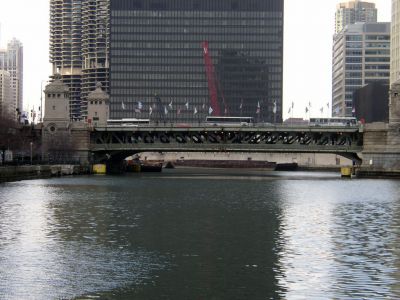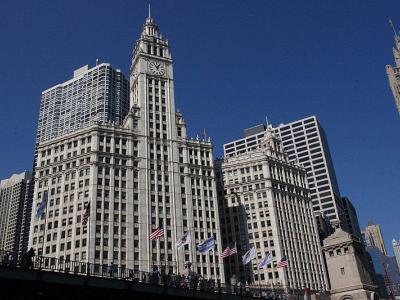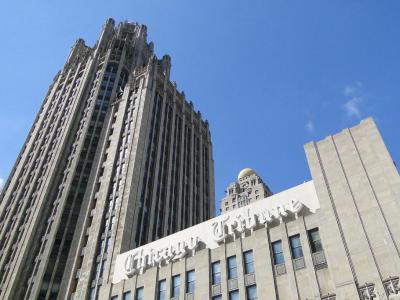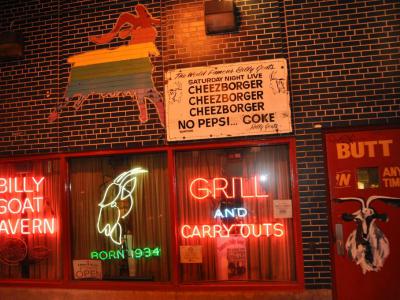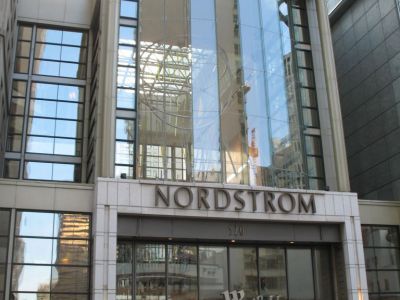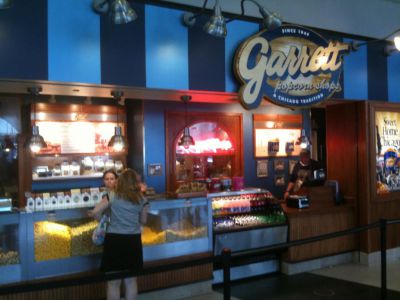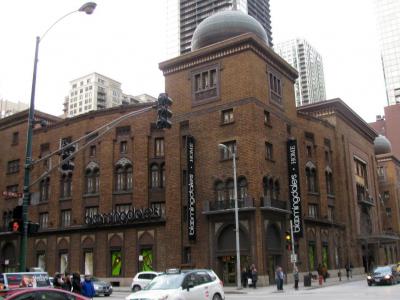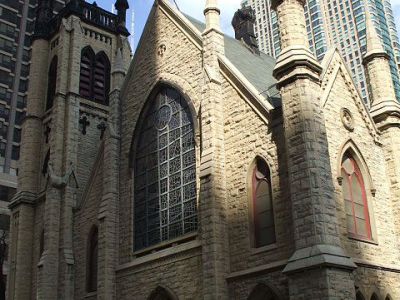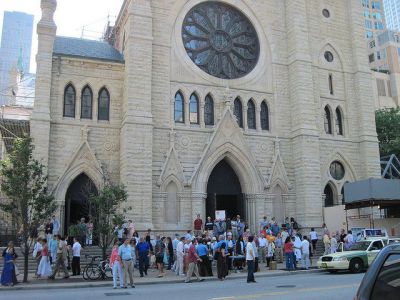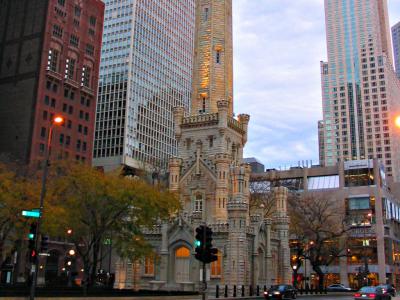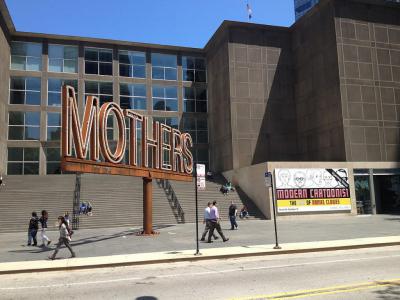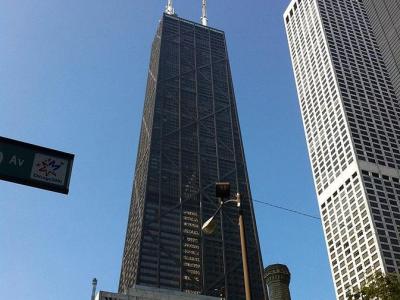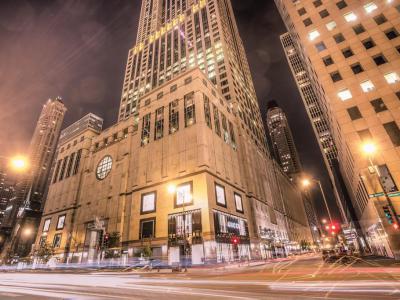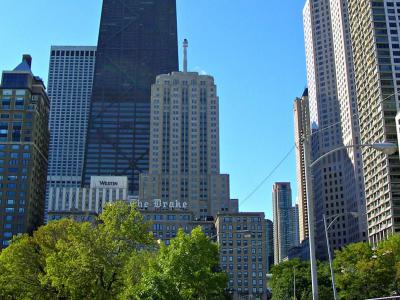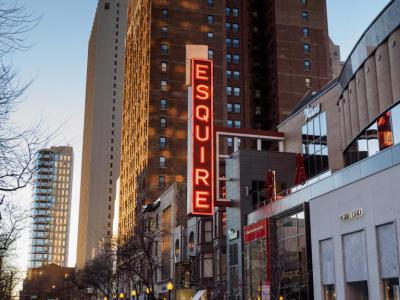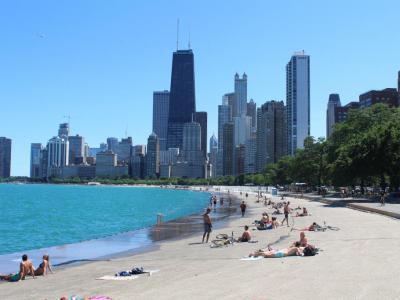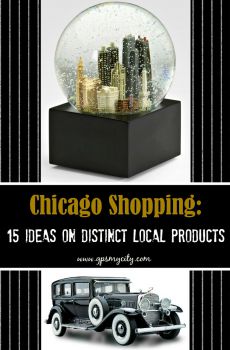The Magnificent Mile Walking Tour (Self Guided), Chicago
The stretch of Michigan Avenue from the Chicago River to Lake Shore Drive, otherwise known as the Magnificent Mile, is regarded as one of the world’s great avenues – or Chicago’s version of Fifth Avenue. Take this self-guided walk to explore its whole stretch and surrounding area, featuring a wide selection of amazing stores/malls, world-known museums, restaurants and spectacular architecture.
Begin at Michigan Avenue Bridge by taking the bridge steps up to the street and looking across the river to see the Wrigley Building. The tower is best admired from outside, where you can take in the French Renaissance-style architecture and magnificent clock tower.
Afterwards, admire the giant Abraham Lincoln statue at the nearby Tribune Tower’s entrance, and look closely at the relief pieces on the lower level. Many rocks and materials from famous buildings around the world have been laid into the brick.
For a fun throwback blast from the past, visit the Original Billy Goat Tavern – so fun that it’s below street level! Beer is in cold frosty glasses, burgers hits the spot, and you’ll love the old-school diner vibe.
Walking further along the Magnificent Mile means passing alongside several other iconic buildings such as the super stylish and historic InterContinental Hotel, the second-oldest water tower in the U.S. (built in 1869), and the John Hancock Center with its popular ‘360 Chicago’ experience.
Don’t miss the three main department stores (900 North Michigan Shops, Water Tower Place, and the shops at Westfield North Bridge), as well as the many cultural diversions along the way, topped by the scenic Oak Street Beach at the end of the route.
For an excellent day out on and around the Magnificent Mile, follow our self-guided walking tour!
Begin at Michigan Avenue Bridge by taking the bridge steps up to the street and looking across the river to see the Wrigley Building. The tower is best admired from outside, where you can take in the French Renaissance-style architecture and magnificent clock tower.
Afterwards, admire the giant Abraham Lincoln statue at the nearby Tribune Tower’s entrance, and look closely at the relief pieces on the lower level. Many rocks and materials from famous buildings around the world have been laid into the brick.
For a fun throwback blast from the past, visit the Original Billy Goat Tavern – so fun that it’s below street level! Beer is in cold frosty glasses, burgers hits the spot, and you’ll love the old-school diner vibe.
Walking further along the Magnificent Mile means passing alongside several other iconic buildings such as the super stylish and historic InterContinental Hotel, the second-oldest water tower in the U.S. (built in 1869), and the John Hancock Center with its popular ‘360 Chicago’ experience.
Don’t miss the three main department stores (900 North Michigan Shops, Water Tower Place, and the shops at Westfield North Bridge), as well as the many cultural diversions along the way, topped by the scenic Oak Street Beach at the end of the route.
For an excellent day out on and around the Magnificent Mile, follow our self-guided walking tour!
How it works: Download the app "GPSmyCity: Walks in 1K+ Cities" from Apple App Store or Google Play Store to your mobile phone or tablet. The app turns your mobile device into a personal tour guide and its built-in GPS navigation functions guide you from one tour stop to next. The app works offline, so no data plan is needed when traveling abroad.
The Magnificent Mile Walking Tour Map
Guide Name: The Magnificent Mile Walking Tour
Guide Location: USA » Chicago (See other walking tours in Chicago)
Guide Type: Self-guided Walking Tour (Sightseeing)
# of Attractions: 18
Tour Duration: 3 Hour(s)
Travel Distance: 4.0 Km or 2.5 Miles
Author: doris
Sight(s) Featured in This Guide:
Guide Location: USA » Chicago (See other walking tours in Chicago)
Guide Type: Self-guided Walking Tour (Sightseeing)
# of Attractions: 18
Tour Duration: 3 Hour(s)
Travel Distance: 4.0 Km or 2.5 Miles
Author: doris
Sight(s) Featured in This Guide:
- DuSable Bridge
- Wrigley Building
- Tribune Tower
- Billy Goat Tavern (The Original)
- The Shops at North Bridge
- InterContinental Chicago Hotel
- Garrett Popcorn
- Medinah Temple
- St. James Cathedral
- Holy Name Cathedral
- Chicago Water Tower
- Museum of Contemporary Art
- 875 North Michigan Avenue – 360 Chicago Observation Deck
- 900 North Michigan Shops
- Palmolive Building
- The Drake
- Oak Street
- Oak Street Beach
1) DuSable Bridge
Chicago boasts one of the largest collections of movable bridges in the world, with trunnion bascules being the predominant type. This particular bridge, well-suited for its prominent and bustling location, elegantly spans the river without any protruding superstructures, maintaining a generous, navigable channel. Its construction held paramount importance in the 1909 Plan of Chicago, serving as a catalyst for the rapid revitalization of real estate along North Michigan Avenue. Drawing inspiration from the design of Paris's Alexander III Bridge (1900), it features four corner pylons, decorative abutments, a gracefully flat arch profile, and seamlessly integrated embankments.
The forty-foot pylons, serving as functional operator houses, are adorned with sculptural reliefs narrating key events in Chicago's history. These include the explorations of Marquette and Joliet, the establishment of the city by trader Jean Baptiste Point du Sable, the Fort Dearborn Massacre of 1812, and the city's reconstruction following the devastating Great Chicago Fire of 1871. A commemorative plaque marks the site of the fort at the southern end of the bridge. Additionally, the southwest structure now houses a museum operated by the Friends of the Chicago River, open seasonally, providing visitors with the opportunity to observe the inner workings of the bridge's gears responsible for its opening and closing.
The forty-foot pylons, serving as functional operator houses, are adorned with sculptural reliefs narrating key events in Chicago's history. These include the explorations of Marquette and Joliet, the establishment of the city by trader Jean Baptiste Point du Sable, the Fort Dearborn Massacre of 1812, and the city's reconstruction following the devastating Great Chicago Fire of 1871. A commemorative plaque marks the site of the fort at the southern end of the bridge. Additionally, the southwest structure now houses a museum operated by the Friends of the Chicago River, open seasonally, providing visitors with the opportunity to observe the inner workings of the bridge's gears responsible for its opening and closing.
2) Wrigley Building
Just a hop, skip, and a coffee spill away from the Tribune Tower, you'll find the Wrigley Building-Chicago’s porcelain crown jewel, proudly gleaming like it just got polished for a big date. Locals love it, tourists photograph it endlessly, and the river? It just reflects it lovingly from both sides, east and west, like a doting parent.
But this beauty isn’t just showing off-it’s got history in its bones, encapsulating the essence of Chicago's architectural history up to the 1920s. Designed by the talented young architect Charles Gerhard Beersman, the structure's tripartite division draws inspiration from European traditions, a common practice among Chicago's commercial architects since the city's rebirth following the 1871 fire. Beersman was inspired by the dazzling effects of the 1893 White City designs in Chicago, leading him to embellish the building with sparkling terra-cotta cladding, using six shades of tile that start creamy at the base and ascend to a cool blue-white glow at the top. It’s like the building’s own version of a sunrise...
And at night, it doesn't go to bed either-getting lit up by a dramatic floodlight show, turning into a glowing lighthouse for downtown romantics and architecture nerds alike.
Just next door, at 401 North Wabash Avenue, is the younger, shinier neighbor: the mirrored oval Trump International Hotel & Tower. It shot up in 2008, soaring 92 stories high, briefly snagging the title of America’s second-tallest building. Originally, Donald Trump had ambitious plans to make it the world's tallest building, but these were scaled back in the aftermath of the September 11 attacks. But it still stands tall, sleek, and self-assured, curving to match the river and subtly bowing to the Wrigley Building’s elegance. Inside, it houses a luxurious hotel, opulent condos, and a fine dining establishment.
Pro tip:
Pop into the Wrigley lobby during business hours and feast your eyes on some seriously impressive brasswork. It’s like stepping into a jewelry box-only taller.
But this beauty isn’t just showing off-it’s got history in its bones, encapsulating the essence of Chicago's architectural history up to the 1920s. Designed by the talented young architect Charles Gerhard Beersman, the structure's tripartite division draws inspiration from European traditions, a common practice among Chicago's commercial architects since the city's rebirth following the 1871 fire. Beersman was inspired by the dazzling effects of the 1893 White City designs in Chicago, leading him to embellish the building with sparkling terra-cotta cladding, using six shades of tile that start creamy at the base and ascend to a cool blue-white glow at the top. It’s like the building’s own version of a sunrise...
And at night, it doesn't go to bed either-getting lit up by a dramatic floodlight show, turning into a glowing lighthouse for downtown romantics and architecture nerds alike.
Just next door, at 401 North Wabash Avenue, is the younger, shinier neighbor: the mirrored oval Trump International Hotel & Tower. It shot up in 2008, soaring 92 stories high, briefly snagging the title of America’s second-tallest building. Originally, Donald Trump had ambitious plans to make it the world's tallest building, but these were scaled back in the aftermath of the September 11 attacks. But it still stands tall, sleek, and self-assured, curving to match the river and subtly bowing to the Wrigley Building’s elegance. Inside, it houses a luxurious hotel, opulent condos, and a fine dining establishment.
Pro tip:
Pop into the Wrigley lobby during business hours and feast your eyes on some seriously impressive brasswork. It’s like stepping into a jewelry box-only taller.
3) Tribune Tower
Not far from where the Chicago River takes a polite little turn near Michigan Avenue, stands the Tribune Tower-looking less like an office building and more like a Gothic cathedral that decided to moonlight in journalism. Complete with its flying buttresses and intricate stone scrollwork, this towering marvel was finished in 1925 to house the Chicago Tribune newspaper, thanks to the generous-and let’s say flamboyant-backing of its editor-publisher Robert "The Colonel" McCormick. Together with his charmingly disheveled partner, Joseph Patterson, the Colonel kicked off a global design contest in 1922 to mark the paper’s 75th birthday. The challenge was to create the most beautiful office building in the world. No pressure, indeed...
The winning plan came from the American duo, John Mead Howells and Raymond Hood, who rebelled against the angular, mass-produced industrial decoration monotony by embracing Britain’s Arts and Crafts movement. The result was a façade crawling with sculpted flora, fauna, and cameos from Aesop’s fables-yes, that same ancient Greek guy with the talking animals. While here, don't miss the entryway stonework, where wise owls and mischievous foxes still whisper stories to the curious.
Step into the lobby and you’re greeted by patriotic marble poetry-quotations about the freedom of the press etched into nearly every surface. And then there’s the pièce de résistance: a massive relief map of North America made of plaster and shredded U.S. dollars. Fun fact: it used to include parts of South America too… until The Colonel decided to literally cut the competition.
Though the Tribune packed up its typewriters in 2018 and the place now hosts luxury condos, the building’s grandeur hasn’t skipped a beat. The outer walls still proudly display their global passport, featuring embedded stones from architectural icons like the Parthenon, the Taj Mahal, Westminster Abbey, and even the Great Wall of China. A newspaper’s vanity project? Maybe. A stunning piece of living history? Absolutely.
The winning plan came from the American duo, John Mead Howells and Raymond Hood, who rebelled against the angular, mass-produced industrial decoration monotony by embracing Britain’s Arts and Crafts movement. The result was a façade crawling with sculpted flora, fauna, and cameos from Aesop’s fables-yes, that same ancient Greek guy with the talking animals. While here, don't miss the entryway stonework, where wise owls and mischievous foxes still whisper stories to the curious.
Step into the lobby and you’re greeted by patriotic marble poetry-quotations about the freedom of the press etched into nearly every surface. And then there’s the pièce de résistance: a massive relief map of North America made of plaster and shredded U.S. dollars. Fun fact: it used to include parts of South America too… until The Colonel decided to literally cut the competition.
Though the Tribune packed up its typewriters in 2018 and the place now hosts luxury condos, the building’s grandeur hasn’t skipped a beat. The outer walls still proudly display their global passport, featuring embedded stones from architectural icons like the Parthenon, the Taj Mahal, Westminster Abbey, and even the Great Wall of China. A newspaper’s vanity project? Maybe. A stunning piece of living history? Absolutely.
4) Billy Goat Tavern (The Original)
In the depths beneath Michigan Avenue, there exists a legendary dive known and cherished by many. This place was already the stuff of legends before John Belushi made the staff's rants immortal on 'Saturday Night Live' back in the 1970s. ("Cheezeborger, cheezeborger! No Pepsi – Coke! No fries – chips!") Even though they decided to open a second, fancier location at Navy Pier, fame hasn't changed the original dive one bit. The grub is affordable and delicious, the staff is so friendly they could charm a grizzly bear, and the people-watching? Well, it's basically an Olympic sport here. So, whether you're taking a breather from touristy stuff or making a late-night pilgrimage to this bar – a place that proudly sports wood-paneled walls and floors that have seen better days – it's either got the best atmosphere ever or... well, it depends on your perspective, really.
Now, if you're a history buff, you'll love this: The joint was founded by a Greek immigrant named Billy Sianis way back in 1934. The man bought it with a check that probably had more bounces than a kangaroo on a trampoline – but eventually, the check cleared, and the locale became a hotspot. It was so close to the Chicago Tribune and Sun-Times offices that it became the go-to hangout for ink-stained wretches and scribblers. Sianis's place was in the newspapers more often than horoscopes, thanks to popular scribe Mike Royko.
Now, let's talk curses, shall we? This tavern is also notorious for the legendary "Curse of the Billy Goat" that befell the Chicago Cubs. Here's the scoop: Billy, a die-hard Cubs fan, decided to bring his pet goat, the tavern's mascot, to Game 4 of the 1945 World Series between the Cubs and the Tigers at Wrigley Field. But Cubs' owner Philip K. Wrigley took one whiff and promptly kicked Billy and his goat out because, well, the goat stank. In retaliation, Billy placed a curse on the Cubs, declaring that there would never be another series game at Wrigley Field. And believe it or not, that curse held its own until 2016 – talk about a lasting legacy!
Now, if you're a history buff, you'll love this: The joint was founded by a Greek immigrant named Billy Sianis way back in 1934. The man bought it with a check that probably had more bounces than a kangaroo on a trampoline – but eventually, the check cleared, and the locale became a hotspot. It was so close to the Chicago Tribune and Sun-Times offices that it became the go-to hangout for ink-stained wretches and scribblers. Sianis's place was in the newspapers more often than horoscopes, thanks to popular scribe Mike Royko.
Now, let's talk curses, shall we? This tavern is also notorious for the legendary "Curse of the Billy Goat" that befell the Chicago Cubs. Here's the scoop: Billy, a die-hard Cubs fan, decided to bring his pet goat, the tavern's mascot, to Game 4 of the 1945 World Series between the Cubs and the Tigers at Wrigley Field. But Cubs' owner Philip K. Wrigley took one whiff and promptly kicked Billy and his goat out because, well, the goat stank. In retaliation, Billy placed a curse on the Cubs, declaring that there would never be another series game at Wrigley Field. And believe it or not, that curse held its own until 2016 – talk about a lasting legacy!
5) The Shops at North Bridge
The shopping complex once known as Westfield North Bridge has undergone a name makeover and is now referred to as "The Shops at North Bridge". This sprawling hub of urban retail and entertainment officially has Nordstrom as its anchor store – a heavyweight competitor in the retail arena, giving the likes of Macy's and Neiman Marcus a run for their money. Alongside Nordstrom, you'll find stylish establishments like Hugo Boss, APM Monaco, MCM Worldwide, and MAC Cosmetics, which collectively elevate the mall experience and add flair to the Magnificent Mile shopping scene.
But that's not all; North Bridge isn't just about shopping. It also houses five hotels, three parking garages, and two office buildings. Among these stands the American Medical Association building on State Street, a creation of Japanese architect Kenzo Tange, and the oldest structure in this complex. It's a vast venue, but fear not! The main entrance atrium has a concierge desk that's like a human Google, ready to provide you with all the answers.
And let's talk about food – because shopping can work up an appetite, and this four-level shopping center offers quite a few dining options. You can savor the flavors of Eataly, indulge in the surf and turf at Joe's Seafood Prime Steak & Stone Crab, relish the finest seafood at Eddie V’s Prime Seafood, grab a casual bite at Doc B's Restaurant, or sink your teeth into some juicy burgers at Shake Shack.
But that's not all; North Bridge isn't just about shopping. It also houses five hotels, three parking garages, and two office buildings. Among these stands the American Medical Association building on State Street, a creation of Japanese architect Kenzo Tange, and the oldest structure in this complex. It's a vast venue, but fear not! The main entrance atrium has a concierge desk that's like a human Google, ready to provide you with all the answers.
And let's talk about food – because shopping can work up an appetite, and this four-level shopping center offers quite a few dining options. You can savor the flavors of Eataly, indulge in the surf and turf at Joe's Seafood Prime Steak & Stone Crab, relish the finest seafood at Eddie V’s Prime Seafood, grab a casual bite at Doc B's Restaurant, or sink your teeth into some juicy burgers at Shake Shack.
6) InterContinental Chicago Hotel
Erected in 1929, during Chicago's skyscraper heyday, this hotel is a captivating blend of architectural influences, including Egyptian, Greek, Art Deco, Gothic, and medieval styles. The result is an impressive tower with various intricately carved segments crowned by a dome gilded in gold leaf. Neo-Egyptian low reliefs are carved into three sides of the façade, showcasing masons on the south, builders on the north, and architects presenting a model of the building to the Pharaoh on the west. Originally serving as the Medinah Athletic Club, this 42-story marvel housed a boxing arena, an archery range, and an Olympic-sized swimming pool, which is still intact.
While you're in the vicinity, be sure to swing by the concierge desk, where you can grab an iPod for an audio tour of the original Athletic Club's public spaces. In under half an hour, this tour will lead you to some captivating interior rooms, each exuding a flamboyant and elegant charm steeped in romantic historical ambiance. The Grand Ballroom boasts a centerpiece that's no lightweight – a 12,000-pound Baccarat crystal chandelier, the largest of its kind in North America. There's also a more masculine "smoking lounge" with heavy timbering, lavish stained glass, and a hand-painted ceiling that tells tales of King Arthur and Parsifal.
There is a lot more to see here – last but not least, the elevated full-size indoor pool holding a staggering 120,000 gallons of water and named after Johnny Weissmuller, the famous Olympic athlete and actor who honed his skills in it. The pool's blue Spanish majolica tiles and terra-cotta fountain of Neptune remain unchanged and will make a trip here even more worthwhile. And if you need a caffeine fix or fancy a steak, you're in luck – there's a Starbucks and Michael Jordan's Steak House on the ground level. Plus, just around the corner, you'll find Garrett’s Popcorn and the NBC studios for a well-rounded experience.
While you're in the vicinity, be sure to swing by the concierge desk, where you can grab an iPod for an audio tour of the original Athletic Club's public spaces. In under half an hour, this tour will lead you to some captivating interior rooms, each exuding a flamboyant and elegant charm steeped in romantic historical ambiance. The Grand Ballroom boasts a centerpiece that's no lightweight – a 12,000-pound Baccarat crystal chandelier, the largest of its kind in North America. There's also a more masculine "smoking lounge" with heavy timbering, lavish stained glass, and a hand-painted ceiling that tells tales of King Arthur and Parsifal.
There is a lot more to see here – last but not least, the elevated full-size indoor pool holding a staggering 120,000 gallons of water and named after Johnny Weissmuller, the famous Olympic athlete and actor who honed his skills in it. The pool's blue Spanish majolica tiles and terra-cotta fountain of Neptune remain unchanged and will make a trip here even more worthwhile. And if you need a caffeine fix or fancy a steak, you're in luck – there's a Starbucks and Michael Jordan's Steak House on the ground level. Plus, just around the corner, you'll find Garrett’s Popcorn and the NBC studios for a well-rounded experience.
7) Garrett Popcorn
Garrett Popcorn, the American chain of gourmet popcorn stores founded in Chicago in 1949, is rightfully considered part of classic Chicago cuisine. As of the latest tally, Garrett has an impressive array of – eleven – distinct popcorn flavors, available in both Crisp and Regular styles.
Among its nut-infused varieties, you'll find Pecan, Macadamia, Cashew, and Almond. Complementing these are a cornucopia of flavors such as Ranch, Caramel, Cheesy Corn, Buttery, and Plain. But perhaps the ultimate indulgence of them all is the irresistible Garrett Mix – a clever fusion of Caramel and Cheddar.
The tale of Garrett Popcorn Shops began in 1949 when the very first store sprang to life on Madison Street. Fast forward to today, Garrett has expanded its reach to nine countries and counting, with offices stationed in Chicago, Singapore, and Tokyo. And in case you didn't know, Garrett also holds the reins of the renowned Frango brand of chocolates, although, let's be clear, chocolate-covered popcorn hasn't quite made it into the serious consideration category.
The popcorn recipes at Garrett are the firm's TOP SECRET, guarded like precious treasures. In 2002, even Oprah (Winfrey) couldn't resist the allure, declaring a container of Garrett's Popcorn one of her "favorite things". Strolling along State Street, the tantalizing aroma of Garrett's signature blends wafts through the air, tempting you from a block away. The siren call of cheddar and caramel is enough to turn even the most cautious tourist into a gleeful snacker.
Tip:
To steer clear of the lines, you can place an advance order on their website. Then, simply waltz over to the pickup window at select Garrett's locations, including the one right on the Mag Mile.
Among its nut-infused varieties, you'll find Pecan, Macadamia, Cashew, and Almond. Complementing these are a cornucopia of flavors such as Ranch, Caramel, Cheesy Corn, Buttery, and Plain. But perhaps the ultimate indulgence of them all is the irresistible Garrett Mix – a clever fusion of Caramel and Cheddar.
The tale of Garrett Popcorn Shops began in 1949 when the very first store sprang to life on Madison Street. Fast forward to today, Garrett has expanded its reach to nine countries and counting, with offices stationed in Chicago, Singapore, and Tokyo. And in case you didn't know, Garrett also holds the reins of the renowned Frango brand of chocolates, although, let's be clear, chocolate-covered popcorn hasn't quite made it into the serious consideration category.
The popcorn recipes at Garrett are the firm's TOP SECRET, guarded like precious treasures. In 2002, even Oprah (Winfrey) couldn't resist the allure, declaring a container of Garrett's Popcorn one of her "favorite things". Strolling along State Street, the tantalizing aroma of Garrett's signature blends wafts through the air, tempting you from a block away. The siren call of cheddar and caramel is enough to turn even the most cautious tourist into a gleeful snacker.
Tip:
To steer clear of the lines, you can place an advance order on their website. Then, simply waltz over to the pickup window at select Garrett's locations, including the one right on the Mag Mile.
8) Medinah Temple
Originally constructed as a Shriner's Temple, the Medinah is an exquisite exemplar of Moorish Revival architecture with intricate textured brickwork arranged in a distinctive Flemish bond pattern. Amidst its other distinctive features are the pointed, bulbous domes and graceful horseshoe arches, echoing the Islamic design influence prevalent in many Shriner's Temples. Many of the key elements, including the intricate geometric motifs around the windows and doorways, evoke images of mosques and palaces typically found in Spain.
Having once resonated with the melodies of the Chicago Symphony Orchestra, with some of their most iconic recordings emanating from within its walls during the late 1960s through the 1980s, this Windy City landmark has been repurposed to house Bloomingdale's home store, which occupied this space for nearly two decades before its relocation in 2020. While the interior underwent significant changes to accommodate retail displays, the dome was painstakingly restored, preserving the building's original character, while stained glass windows and the exterior were repaired.
On May 5, 2022, news broke that the Medinah Temple would serve as a temporary casino, a key component of the approved Bally's Chicago casino bid endorsed by the Chicago Mayor and City Council. The temporary casino officially welcomed patrons on September 9, 2023, and it's anticipated to remain at the Medinah Temple until the permanent casino location in the River West neighborhood is completed, a project slated for fulfillment by 2026.
Tip:
The second-floor women's restroom may pique your interest, as it boasts the title of Chicago's most beautiful bathroom.
Having once resonated with the melodies of the Chicago Symphony Orchestra, with some of their most iconic recordings emanating from within its walls during the late 1960s through the 1980s, this Windy City landmark has been repurposed to house Bloomingdale's home store, which occupied this space for nearly two decades before its relocation in 2020. While the interior underwent significant changes to accommodate retail displays, the dome was painstakingly restored, preserving the building's original character, while stained glass windows and the exterior were repaired.
On May 5, 2022, news broke that the Medinah Temple would serve as a temporary casino, a key component of the approved Bally's Chicago casino bid endorsed by the Chicago Mayor and City Council. The temporary casino officially welcomed patrons on September 9, 2023, and it's anticipated to remain at the Medinah Temple until the permanent casino location in the River West neighborhood is completed, a project slated for fulfillment by 2026.
Tip:
The second-floor women's restroom may pique your interest, as it boasts the title of Chicago's most beautiful bathroom.
9) St. James Cathedral
Saint James Cathedral, at the intersection of Huron and Wabash Streets, is the "mother church" of Episcopalians in the United States. Its roots trace back to 1834, making it the Windy City's oldest church of its kind. This historic place of worship narrowly escaped annihilation during the catastrophic Great Chicago Fire of 1871, with only the bell tower surviving, which was later incorporated into the present-day reconstructed building. The soot-darkened stones atop the tower serve as poignant reminders of that fateful day.
Saint James assumed the role of a cathedral in 1928, following the destruction of the Cathedral Church of Saints Peter and Paul. Its historical origins harken back to Juliette Kinzie, a Connecticut native and the wife of Indian agent John Harris Kinzie. Even Abraham Lincoln sought solace here shortly after his election as President in 1860. Fast forward to the mid-1980s, Saint James underwent an extensive restoration effort to return the building to its original late 1800s Arts-and-Crafts Gothic Revival design.
Stepping inside, you'll be greeted by a stenciled nave, an exquisite symphony of colors that ranks among the nation's most splendid Victorian interiors. Adding to the grandeur are stained glass windows that depict captivating Biblical scenes. For instance, the choir's rose window features Christ-in-Mercy, encircled by angelic musicians, while the marble altar and checkered marble floor are bathed in the luminance of the Transfiguration, Epiphany, Crucifixion, and Ascension.
And if that's not enough to pique your interest, don't miss Saint Andrew's Chapel, a creation of architect Bertram Goodhue, inspired by medieval Scottish abbeys. This addition to the Cathedral was completed in the early 1920s, adding yet another layer of interest.
Saint James assumed the role of a cathedral in 1928, following the destruction of the Cathedral Church of Saints Peter and Paul. Its historical origins harken back to Juliette Kinzie, a Connecticut native and the wife of Indian agent John Harris Kinzie. Even Abraham Lincoln sought solace here shortly after his election as President in 1860. Fast forward to the mid-1980s, Saint James underwent an extensive restoration effort to return the building to its original late 1800s Arts-and-Crafts Gothic Revival design.
Stepping inside, you'll be greeted by a stenciled nave, an exquisite symphony of colors that ranks among the nation's most splendid Victorian interiors. Adding to the grandeur are stained glass windows that depict captivating Biblical scenes. For instance, the choir's rose window features Christ-in-Mercy, encircled by angelic musicians, while the marble altar and checkered marble floor are bathed in the luminance of the Transfiguration, Epiphany, Crucifixion, and Ascension.
And if that's not enough to pique your interest, don't miss Saint Andrew's Chapel, a creation of architect Bertram Goodhue, inspired by medieval Scottish abbeys. This addition to the Cathedral was completed in the early 1920s, adding yet another layer of interest.
10) Holy Name Cathedral
Journeying north along State Street, your path will lead you to the splendid Holy Name Cathedral, which has recently undergone an extensive restoration. Serving as the seat of the Roman Catholic archdiocese of Chicago, this majestic Gothic Revival church was originally conceived in 1875 by the prolific architect Patrick Charles Keely. By that time, his portfolio already boasted an astounding six hundred churches and sixteen cathedrals, and Holy Name Cathedral stands as a testament to his mastery. The church's grandeur is evident in the towering pinnacles and graceful arches, reminiscent of the Gothic churches that grace the landscapes of Europe.
Venturing inside, you'll encounter a treasure trove of contemporary spiritual artistry. From the suspended sculpted resurrection crucifix that hangs from the ceiling to the bronze-cast Stations of the Cross on the nave walls, every detail exudes reverence and grace. Take a moment to appreciate the vaulted ceiling, the bundled piers, and the intricate wooden tracery, all symbolizing the mystical Tree of Life. Also, cast your gaze upon the high-hung red decorations above the sanctuary – these are the cardinals' hats, or 'galeros', each representing one of the city's past cardinals.
Why You Should Visit:
Undoubtedly one of the most impressive cathedrals in the United States, standing shoulder to shoulder with its European counterparts. While it may not be the largest in size, its breathtaking stone exterior, awe-inspiring wooden interior, and resplendent stained glass, all in the classic Gothic style, make it a must-see destination for anyone with an appreciation for religious and architectural splendor.
Venturing inside, you'll encounter a treasure trove of contemporary spiritual artistry. From the suspended sculpted resurrection crucifix that hangs from the ceiling to the bronze-cast Stations of the Cross on the nave walls, every detail exudes reverence and grace. Take a moment to appreciate the vaulted ceiling, the bundled piers, and the intricate wooden tracery, all symbolizing the mystical Tree of Life. Also, cast your gaze upon the high-hung red decorations above the sanctuary – these are the cardinals' hats, or 'galeros', each representing one of the city's past cardinals.
Why You Should Visit:
Undoubtedly one of the most impressive cathedrals in the United States, standing shoulder to shoulder with its European counterparts. While it may not be the largest in size, its breathtaking stone exterior, awe-inspiring wooden interior, and resplendent stained glass, all in the classic Gothic style, make it a must-see destination for anyone with an appreciation for religious and architectural splendor.
11) Chicago Water Tower
The intersection of Michigan Avenue and Pearson Street in Chicago serves as a fascinating meeting point between the city's historical legacy and its contemporary identity. Here, the towering Water Tower Place, long considered the pinnacle of Chicago shopping, stands in contrast to one of the few remaining remnants of Old Chicago: the historic Water Tower. This unique limestone structure, adorned with peculiar turrets that Oscar Wilde humorously described as resembling "a castellated monstrosity with pepper boxes stuck all over it," was constructed in 1869 to accommodate a standpipe, regulating water pressure from the nearby Pumping Station.
Both of these edifices played pivotal roles in the city's ambitious endeavor to provide safe drinking water to its burgeoning population. It wasn't until 1900, when the city reversed the flow of the Chicago River to redirect its waste southward toward St. Louis, that this goal was truly achieved. Remarkably, these buildings withstood the devastating Great Fire of 1871 that consumed much of downtown Chicago, becoming enduring symbols of the city's resilience and remaining among its most iconic landmarks.
Today, the interior of the Water Tower has been repurposed to host temporary photo exhibitions centered around Chicago themes, while the Pumping Station houses the Chicago Water Works Visitor Center, where visitors can obtain a wealth of maps, brochures, and information about the latest cultural events happening throughout the city. Notably, a recent addition to the Pumping Station is a 270-seat theater that showcases productions by the Lookingglass Theatre Company.
Both of these edifices played pivotal roles in the city's ambitious endeavor to provide safe drinking water to its burgeoning population. It wasn't until 1900, when the city reversed the flow of the Chicago River to redirect its waste southward toward St. Louis, that this goal was truly achieved. Remarkably, these buildings withstood the devastating Great Fire of 1871 that consumed much of downtown Chicago, becoming enduring symbols of the city's resilience and remaining among its most iconic landmarks.
Today, the interior of the Water Tower has been repurposed to host temporary photo exhibitions centered around Chicago themes, while the Pumping Station houses the Chicago Water Works Visitor Center, where visitors can obtain a wealth of maps, brochures, and information about the latest cultural events happening throughout the city. Notably, a recent addition to the Pumping Station is a 270-seat theater that showcases productions by the Lookingglass Theatre Company.
12) Museum of Contemporary Art
Dedicated to showcasing art that pushes boundaries and elicits strong reactions, the Museum of Contemporary Art occupies an angular structure crafted by German architect Josef Paul Kleihues. While the exterior may not steal the show, the interior offers a plethora of reasons to visit. The four-story atrium, enveloped in glass walls, treats visitors to spectacular vistas. Ascending to the top floor, you'll discover barrel-vaulted galleries bathed in soft, indirect natural light, while tucked against the northern wall, a graceful staircase winds around an almond-shaped reflecting pool.
Museum facilities span all four levels. The ground floor hosts the lower level of the gift shop and an auditorium. Ascending to the second floor, you'll find the upper level of the gift shop, a spacious area for temporary exhibitions, and the sleek Puck’s at the MCA café – a spot best savored during the summer when the terrace is open. The third and fourth floors play host to rotating displays from the museum's permanent collection. On the third floor, you'll likely encounter Modernist mobiles by the likes of Alexander Calder, with a local art enthusiast generously lending the museum fifteen of Calder's abstract sculptures on an indefinite basis. Among them, the monochromatic 'Black 17 Dots and The Ghost' stands out, a testament to Calder's penchant for employing vibrant colors.
Venturing to the fourth floor, you can expect to encounter works by modern art stalwarts such as Jasper Johns, Sol LeWitt, and René Magritte, alongside more contemporary creations. It's highly probable that you'll encounter pieces by Bruce Nauman, given that the MCA boasts one of the most extensive collections of his work. Nauman is renowned for his attention-grabbing neon slogans, such as 'Life Death Love Hate Pleasure Pain', but he also explored the realms of video and audio environments, photography, sculpture, and drawing.
Museum facilities span all four levels. The ground floor hosts the lower level of the gift shop and an auditorium. Ascending to the second floor, you'll find the upper level of the gift shop, a spacious area for temporary exhibitions, and the sleek Puck’s at the MCA café – a spot best savored during the summer when the terrace is open. The third and fourth floors play host to rotating displays from the museum's permanent collection. On the third floor, you'll likely encounter Modernist mobiles by the likes of Alexander Calder, with a local art enthusiast generously lending the museum fifteen of Calder's abstract sculptures on an indefinite basis. Among them, the monochromatic 'Black 17 Dots and The Ghost' stands out, a testament to Calder's penchant for employing vibrant colors.
Venturing to the fourth floor, you can expect to encounter works by modern art stalwarts such as Jasper Johns, Sol LeWitt, and René Magritte, alongside more contemporary creations. It's highly probable that you'll encounter pieces by Bruce Nauman, given that the MCA boasts one of the most extensive collections of his work. Nauman is renowned for his attention-grabbing neon slogans, such as 'Life Death Love Hate Pleasure Pain', but he also explored the realms of video and audio environments, photography, sculpture, and drawing.
13) 875 North Michigan Avenue – 360 Chicago Observation Deck (must see)
Designed by the architectural talents of Skidmore, Owings & Merrill, this versatile skyscraper, formerly known as the John Hancock Center, is instantly recognizable for its narrowing silhouette and massive X-shaped braces, serving as sturdy reinforcements for its towering stature of 100 stories. Shortly after its completion in 1970, it earned the affectionate moniker "Big John", and it's no wonder why – soaring to a staggering height of 1,127 feet (or 1,506 feet, counting its antennae in the taller east tower).
Housing an array of amenities, including retail spaces, parking facilities, offices, a restaurant, and residential units, it's often likened to a self-contained city within a city. When viewed from a distance, however, the building exudes an austere yet captivating elegance, epitomizing the International style championed by the legendary Mies van der Rohe.
Much like its architectural sibling, the Willis Tower, also designed by the same architectural team, this skyscraper offers sweeping vistas that span four states (Illinois, Indiana, Michigan, and Wisconsin) on clear days. To witness this spectacle, ascend to the 94th-floor observatory, now rebranded as 360 CHICAGO (admission fee: $30). While you're there, why not savor a cocktail, beer, wine, hot beverage, or non-alcoholic refreshment at the CloudBar, an exclusive perk for General Admission ticket holders.
For the thrill-seekers in the crowd, an additional fee unlocks the tower's most exhilarating feature – The Tilt ($8). This heart-pounding experience features eight windows that tilt downward to a daring 30-degree angle, providing a unique perspective of the city below.
Bonus tip:
Just across from the skyscraper stands the Fourth Presbyterian Church, boasting English and French Gothic influences, and dating to 1914. Step inside to admire its elegant interior and tranquil courtyard – a surprisingly serene oasis just a stone's throw from Michigan Avenue.
Housing an array of amenities, including retail spaces, parking facilities, offices, a restaurant, and residential units, it's often likened to a self-contained city within a city. When viewed from a distance, however, the building exudes an austere yet captivating elegance, epitomizing the International style championed by the legendary Mies van der Rohe.
Much like its architectural sibling, the Willis Tower, also designed by the same architectural team, this skyscraper offers sweeping vistas that span four states (Illinois, Indiana, Michigan, and Wisconsin) on clear days. To witness this spectacle, ascend to the 94th-floor observatory, now rebranded as 360 CHICAGO (admission fee: $30). While you're there, why not savor a cocktail, beer, wine, hot beverage, or non-alcoholic refreshment at the CloudBar, an exclusive perk for General Admission ticket holders.
For the thrill-seekers in the crowd, an additional fee unlocks the tower's most exhilarating feature – The Tilt ($8). This heart-pounding experience features eight windows that tilt downward to a daring 30-degree angle, providing a unique perspective of the city below.
Bonus tip:
Just across from the skyscraper stands the Fourth Presbyterian Church, boasting English and French Gothic influences, and dating to 1914. Step inside to admire its elegant interior and tranquil courtyard – a surprisingly serene oasis just a stone's throw from Michigan Avenue.
14) 900 North Michigan Shops
Ditch any preconceived notions you may have about shopping malls being dull suburban landscapes. Among the Mag Mile's retail gems like Water Tower Place and The Shops at North Bridge, you'll discover the 900 North Michigan Shops, an upscale haven. In fact, it's the most prestigious of them all, boasting an impressive lineup of tenants and fine dining establishments. Its sophisticated Deco design perfectly complements the high-end atmosphere of the boutiques it hosts. As you stroll through, you'll encounter the Chicago outposts of retail giants like Bloomingdale's and L.K. Bennett, along with a myriad of boutique stores including Gucci, J. Crew, and Psycho Bunny.
Architecturally, this mixed-use structure, brought to life by the creators of Water Tower Place, builds upon the commercial triumphs of its predecessor while rectifying some past shortcomings. The eight-story shopping block boldly extends to the lot line, greeting visitors with a welcoming entrance and generous, eye-catching display windows to entice passersby. Inside, a spacious yet understated neo-Deco atrium welcomes you, cleverly positioning the anchor store towards the rear so that shoppers encounter the boutique offerings first. Entrances to the hotel, offices, and condominium floors are discreetly tucked away on the side streets. Similar to Water Tower Place, the exterior is an ensemble of embellished boxes, albeit with an even more ambitious decorative scheme. While it may not all seamlessly harmonize, the quartet of imposing lanterns adorning the building's pinnacle is an absolute visual treat.
Why You Should Visit:
Really nice collection of high-end stores, providing a truly enjoyable shopping experience, as well as a relaxed place to unwind. Up on the top floor, you'll find an exceptional food court with a variety of options, perfect for sipping a cup of coffee or treating yourself to scrumptious desserts as you immerse yourself in a day of shopping (or perhaps gather inspiration for clothing and jewelry designs).
Architecturally, this mixed-use structure, brought to life by the creators of Water Tower Place, builds upon the commercial triumphs of its predecessor while rectifying some past shortcomings. The eight-story shopping block boldly extends to the lot line, greeting visitors with a welcoming entrance and generous, eye-catching display windows to entice passersby. Inside, a spacious yet understated neo-Deco atrium welcomes you, cleverly positioning the anchor store towards the rear so that shoppers encounter the boutique offerings first. Entrances to the hotel, offices, and condominium floors are discreetly tucked away on the side streets. Similar to Water Tower Place, the exterior is an ensemble of embellished boxes, albeit with an even more ambitious decorative scheme. While it may not all seamlessly harmonize, the quartet of imposing lanterns adorning the building's pinnacle is an absolute visual treat.
Why You Should Visit:
Really nice collection of high-end stores, providing a truly enjoyable shopping experience, as well as a relaxed place to unwind. Up on the top floor, you'll find an exceptional food court with a variety of options, perfect for sipping a cup of coffee or treating yourself to scrumptious desserts as you immerse yourself in a day of shopping (or perhaps gather inspiration for clothing and jewelry designs).
15) Palmolive Building
Once the abode of the Colgate-Palmolive-Peet Corporation, the edifice sprang to life in 1929 courtesy of the wizards at Holabird & Root. These design gurus were renowned for birthing various architectural styles – think Chicago School, Art Deco, Modern Architecture, and even Sustainable Architecture. And guess what category the Palmolive Building fits into? Yep, it's right there in the Art Deco realm.
Back in the day, it was hailed as a "monument to cleanliness", marking a historic first by becoming the first skyscraper to boldly venture far from the Loop, gallantly standing its ground at the northern end of Michigan Avenue. In fact, it was one of the country's pioneering "set-back" Art Deco skyscrapers, setting a trend that would soon become all the rage. "Set-back" designs gained popularity thanks to zoning laws and the sketches of New York architect Hugh Ferns, transforming this structure into a formidable sculptural masterpiece.
Oh, but there's more to the story – the Palmolive Building didn't just light up the skyline; it literally beamed as a navigational beacon from its pinnacle between 1930 and 1931. The shining star, known as the Lindbergh Beacon, perched atop a towering 97-foot spire, was the brainchild of Elmer Sperry, the gyroscopic genius. Sperry's gift to the City of Chicago, the beacon illuminated the way for all; however, in 1981, it met its match – private windows were getting a tad too personal with its glow. But fear not, in 2007, it made a triumphant return, its beam now arcing over Lake Michigan, keeping the peace with no more window-worries.
Back in the day, it was hailed as a "monument to cleanliness", marking a historic first by becoming the first skyscraper to boldly venture far from the Loop, gallantly standing its ground at the northern end of Michigan Avenue. In fact, it was one of the country's pioneering "set-back" Art Deco skyscrapers, setting a trend that would soon become all the rage. "Set-back" designs gained popularity thanks to zoning laws and the sketches of New York architect Hugh Ferns, transforming this structure into a formidable sculptural masterpiece.
Oh, but there's more to the story – the Palmolive Building didn't just light up the skyline; it literally beamed as a navigational beacon from its pinnacle between 1930 and 1931. The shining star, known as the Lindbergh Beacon, perched atop a towering 97-foot spire, was the brainchild of Elmer Sperry, the gyroscopic genius. Sperry's gift to the City of Chicago, the beacon illuminated the way for all; however, in 1981, it met its match – private windows were getting a tad too personal with its glow. But fear not, in 2007, it made a triumphant return, its beam now arcing over Lake Michigan, keeping the peace with no more window-worries.
16) The Drake
If it weren't for its prime location and storied past, Chicago's illustrious Drake Hotel might have fallen by the wayside, overshadowed by its formidable competitors. Positioned across from the coveted Oak Street Beach and graced with outstanding vistas of Lake Michigan and Lake Shore Drive, it seamlessly melds the elegance of the Drive's residential district with the allure of Michigan Avenue.
A brainchild of architect Benjamin Marshall, The Drake drew inspiration from opulent Italian Renaissance palaces. Since its grand opening on a glittering New Year's Eve in 1920, it has become synonymous with wealth and prestige in the Windy City. Presidents, from Herbert Hoover to Bill Clinton and Barack Obama, have favored its hallowed halls, while royalty, silver screen legends, and a kaleidoscope of glitterati have converged here over the years. The list of celebrities includes Walt Disney, Princess Diana, Winston Churchill, Dwight Eisenhower, Liz Taylor, Judy Garland, Frank Sinatra, Joe DiMaggio, Marilyn Monroe, Pope John Paul II, and many more. Notably, the hotel has also made its mark in the movies, with appearances in "Risky Business", "My Best Friend's Wedding", and "Mission: Impossible".
One of the timeless traditions that draws visitors to Chicago is Afternoon Tea, a practice that traces its roots back to 1840. Luminaries such as the Empress of Japan, Princess Diana, and Queen Elizabeth II have all partaken in this esteemed custom at the Drake. The venue for this experience is the Palm Court, adorned entirely in pristine white. The hotel even boasts a signature custom-blend tea, aptly named "Palm Court", comprising four exquisite teas: Indian Assam, Chinese Keemun with chocolate notes, Ceylon, and Formosa Oolong. To add a touch of enchantment, live harp music serenades guests every Wednesday through Sunday. In fact, USA Today recognized the Drake Hotel in 2013 as one of the finest establishments for afternoon tea in the entire nation.
Why You Should Visit:
Not merely a hotel; it's a living, breathing piece of history. Nestled in a charming, pedestrian-friendly neighborhood, it stands steps away from Oak Street Beach and a treasure trove of upscale boutiques.
A brainchild of architect Benjamin Marshall, The Drake drew inspiration from opulent Italian Renaissance palaces. Since its grand opening on a glittering New Year's Eve in 1920, it has become synonymous with wealth and prestige in the Windy City. Presidents, from Herbert Hoover to Bill Clinton and Barack Obama, have favored its hallowed halls, while royalty, silver screen legends, and a kaleidoscope of glitterati have converged here over the years. The list of celebrities includes Walt Disney, Princess Diana, Winston Churchill, Dwight Eisenhower, Liz Taylor, Judy Garland, Frank Sinatra, Joe DiMaggio, Marilyn Monroe, Pope John Paul II, and many more. Notably, the hotel has also made its mark in the movies, with appearances in "Risky Business", "My Best Friend's Wedding", and "Mission: Impossible".
One of the timeless traditions that draws visitors to Chicago is Afternoon Tea, a practice that traces its roots back to 1840. Luminaries such as the Empress of Japan, Princess Diana, and Queen Elizabeth II have all partaken in this esteemed custom at the Drake. The venue for this experience is the Palm Court, adorned entirely in pristine white. The hotel even boasts a signature custom-blend tea, aptly named "Palm Court", comprising four exquisite teas: Indian Assam, Chinese Keemun with chocolate notes, Ceylon, and Formosa Oolong. To add a touch of enchantment, live harp music serenades guests every Wednesday through Sunday. In fact, USA Today recognized the Drake Hotel in 2013 as one of the finest establishments for afternoon tea in the entire nation.
Why You Should Visit:
Not merely a hotel; it's a living, breathing piece of history. Nestled in a charming, pedestrian-friendly neighborhood, it stands steps away from Oak Street Beach and a treasure trove of upscale boutiques.
17) Oak Street
Next to Michigan Avenue lies the charming shopping enclave known as "Oak Street". While some may consider it an integral part of the Magnificent Mile, it's worth noting that neighboring streets like Rush and Walton don't quite make the official cut.
The Oak Street area, though compact in size, possesses the ability to outshine the Mile with its array of ultra-chic boutiques. Here, you'll encounter fashion havens such as Prada, Jimmy Choo, and Jil Sander, along with the slightly more accessible Bebe, Juicy Couture, and Mac. If you're flush with cash, it's an enjoyable destination for retail therapy, albeit with a somewhat more subdued atmosphere compared to the bustling Mile. Moreover, Oak Street is home to a number of opulent historic mansions dating back to the 1800s, a testament to Chicago's wealthiest denizens of yesteryear.
In contrast, Rush Street takes an oblique course from Chicago Avenue to Elm Street and is characterized by its array of bars, sidewalk cafés, and traditional steakhouses, all of which remain lively around the clock. While many of the establishments here cater to tourists and may come with slightly inflated price tags, there are a handful of exceptions, including the Original Pancake House – a quaint, old-school breakfast spot with abundant outdoor seating.
Just a single block north of Elm Street, Division Street is the epicenter of exuberant nightlife, attracting hordes of spirited college students and young professionals come weekend nights. In a curious twist, the addition of middle-aged men on the prowl has earned this area the nickname "the Viagra Triangle". Among the Division Street hotspots, Butch McGuire's reigns supreme, drawing in a lively crowd of singles in pursuit of a good time and exuding all the charm one might expect from a college fraternity house.
The Oak Street area, though compact in size, possesses the ability to outshine the Mile with its array of ultra-chic boutiques. Here, you'll encounter fashion havens such as Prada, Jimmy Choo, and Jil Sander, along with the slightly more accessible Bebe, Juicy Couture, and Mac. If you're flush with cash, it's an enjoyable destination for retail therapy, albeit with a somewhat more subdued atmosphere compared to the bustling Mile. Moreover, Oak Street is home to a number of opulent historic mansions dating back to the 1800s, a testament to Chicago's wealthiest denizens of yesteryear.
In contrast, Rush Street takes an oblique course from Chicago Avenue to Elm Street and is characterized by its array of bars, sidewalk cafés, and traditional steakhouses, all of which remain lively around the clock. While many of the establishments here cater to tourists and may come with slightly inflated price tags, there are a handful of exceptions, including the Original Pancake House – a quaint, old-school breakfast spot with abundant outdoor seating.
Just a single block north of Elm Street, Division Street is the epicenter of exuberant nightlife, attracting hordes of spirited college students and young professionals come weekend nights. In a curious twist, the addition of middle-aged men on the prowl has earned this area the nickname "the Viagra Triangle". Among the Division Street hotspots, Butch McGuire's reigns supreme, drawing in a lively crowd of singles in pursuit of a good time and exuding all the charm one might expect from a college fraternity house.
18) Oak Street Beach
Back in the late 1800s, Chicago's Lake Shore was all peace and quiet, gently sloping from Oak Street to the Chicago River and providing a serene haven for Lakeshore property owners. Then along came George Streeter, a Civil War veteran, carnival enthusiast, steamboat captain, and the brassiest of con-men. His boat, the Reutan, packed with cargo and passengers, found itself marooned on a sandbar.
Now, most folks would've been flustered by such a mishap, but not our George, who decided to get creative! He took that stranded ship, its cargo, and a heap of trash, and voilà, he conjured up a small island, declaring it his very own ship-trash-pier-sand island. Naturally, this led to some heated disputes, including good old-fashioned gunfights. Long story short, George was eventually given the boot. The land he left behind was filled in and got christened Streeterville, which just so happens to be the present site of the 360 Chicago Observation Deck and the illustrious Chicago Water Tower.
Back in the day when this area was a resort, the legendary Drake Hotel made its grand debut in 1920 as a beachfront property. Guests could effortlessly saunter from the changing rooms on the arcade level straight onto the sandy shores. Sadly, the construction of Lake Shore Drive separated the beach from the neighborhood, but fret not – a nifty tunnel ensures easy access, and it remains a primo spot to plop down your towel and take a refreshing dip. Since the sand is in short supply, locals have mastered the art of spreading out on towels along the concrete walkway and taking the plunge when things heat up. And if you fancy a bike ride, a pit stop for snacks, or a visit to the restrooms, you're in luck – these amenities are available seasonally, along with changing rooms, bathrooms, volleyball courts, plus the Oak Street Beach Restaurant, which offers a casual (though somewhat pricey) menu, along with great views of the lake and skyline.
So, there you have it, the story of Oak Street Beach, complete with battles, beachfront hotels, and a whole lot of sun-soaked fun!
Now, most folks would've been flustered by such a mishap, but not our George, who decided to get creative! He took that stranded ship, its cargo, and a heap of trash, and voilà, he conjured up a small island, declaring it his very own ship-trash-pier-sand island. Naturally, this led to some heated disputes, including good old-fashioned gunfights. Long story short, George was eventually given the boot. The land he left behind was filled in and got christened Streeterville, which just so happens to be the present site of the 360 Chicago Observation Deck and the illustrious Chicago Water Tower.
Back in the day when this area was a resort, the legendary Drake Hotel made its grand debut in 1920 as a beachfront property. Guests could effortlessly saunter from the changing rooms on the arcade level straight onto the sandy shores. Sadly, the construction of Lake Shore Drive separated the beach from the neighborhood, but fret not – a nifty tunnel ensures easy access, and it remains a primo spot to plop down your towel and take a refreshing dip. Since the sand is in short supply, locals have mastered the art of spreading out on towels along the concrete walkway and taking the plunge when things heat up. And if you fancy a bike ride, a pit stop for snacks, or a visit to the restrooms, you're in luck – these amenities are available seasonally, along with changing rooms, bathrooms, volleyball courts, plus the Oak Street Beach Restaurant, which offers a casual (though somewhat pricey) menu, along with great views of the lake and skyline.
So, there you have it, the story of Oak Street Beach, complete with battles, beachfront hotels, and a whole lot of sun-soaked fun!
Walking Tours in Chicago, Illinois
Create Your Own Walk in Chicago
Creating your own self-guided walk in Chicago is easy and fun. Choose the city attractions that you want to see and a walk route map will be created just for you. You can even set your hotel as the start point of the walk.
Chicago Introduction Walking Tour
Chicago, perched on the shores of Lake Michigan in Illinois, is a city steeped in history and urban vibrancy. Known by numerous nicknames such as the Windy City and the City of Big Shoulders, it boasts a skyline marked by towering structures. The area of today's Chicago, initially inhabited by Native American tribes, saw its first European-settled reference as "Chicagou" in 1679, a... view more
Tour Duration: 2 Hour(s)
Travel Distance: 3.9 Km or 2.4 Miles
Tour Duration: 2 Hour(s)
Travel Distance: 3.9 Km or 2.4 Miles
Chicago Chinatown Walking Tour
Tucked away just south of the Loop, the Chinatown of Chicago was established in 1912 and is considered one of the best examples of American Chinatown. While it may be one of Chicago’s smallest neighborhoods geographically, it is big on character, colors, sights, sounds, and flavors. Here, you’ll find a wide range of unique boutiques, specialty shops, religious sights, authentic Chinese... view more
Tour Duration: 1 Hour(s)
Travel Distance: 1.7 Km or 1.1 Miles
Tour Duration: 1 Hour(s)
Travel Distance: 1.7 Km or 1.1 Miles
Chicago Navy Pier Walking Tour
Additional to scenic views of the lake, the boats, and the city skyline, the Navy Pier offers a variety of attractions on the waterfront – for kids as well as adults – that draw nearly ten million people annually, making this Chicago's most visited spot. Yes, some may see it as a “tourist trap”, but it is worth the time and money to spend some time here, so take this self-guided walk... view more
Tour Duration: 1 Hour(s)
Travel Distance: 1.0 Km or 0.6 Miles
Tour Duration: 1 Hour(s)
Travel Distance: 1.0 Km or 0.6 Miles
Loop District Architecture Walking Tour
The Chicago Loop District-essentially the city’s historic downtown-has long been a stage for architectural innovation and an open-air museum of American architecture.
The construction boom started after the Great Chicago Fire of 1871, which destroyed much of the central business district, gave architects a blank canvas to rebuild the city from the ground up. What followed was a surge of... view more
Tour Duration: 3 Hour(s)
Travel Distance: 4.7 Km or 2.9 Miles
The construction boom started after the Great Chicago Fire of 1871, which destroyed much of the central business district, gave architects a blank canvas to rebuild the city from the ground up. What followed was a surge of... view more
Tour Duration: 3 Hour(s)
Travel Distance: 4.7 Km or 2.9 Miles
Chicago Old Town Walking Tour
Settled in 1850 by German immigrants, Chicago’s Old Town neighborhood is a popular destination for locals and visitors who cater to the entertainment venues, restaurants, pubs, coffee shops and boutiques – all of which have turned an area once referred to as the “Cabbage Patch” into an attraction that rivals Navy Pier, Wrigley Field and the Magnificent Mile.
Start your Old Town walking... view more
Tour Duration: 2 Hour(s)
Travel Distance: 2.6 Km or 1.6 Miles
Start your Old Town walking... view more
Tour Duration: 2 Hour(s)
Travel Distance: 2.6 Km or 1.6 Miles
Millennium and Grant Parks Walking Tour
If Chicago had a living room, it would be Grant Park - and if it had a shiny new media room, that would definitely be Millennium Park. These two sprawling green spaces hug the lakeshore like the city’s favorite blanket, offering locals and tourists alike a perfect blend of nature, art, and architecture with a side of skyline.
Let’s start with the elder of the two - Grant Park, established... view more
Tour Duration: 2 Hour(s)
Travel Distance: 2.7 Km or 1.7 Miles
Let’s start with the elder of the two - Grant Park, established... view more
Tour Duration: 2 Hour(s)
Travel Distance: 2.7 Km or 1.7 Miles
Useful Travel Guides for Planning Your Trip
Chicago Souvenirs: 15 Distinct Local Products to Bring Home
One of the most fascinating cities in the U.S., if not the whole world, Chicago has no shortage of things closely associated with it, often due to their direct origin (blues, gangstership, etc.), so one might literally be spoiled for choice as to what to choose as a "piece" of Chicago to...
The Most Popular Cities
/ view all



